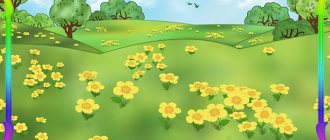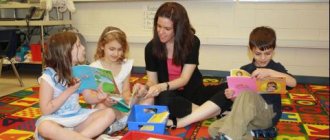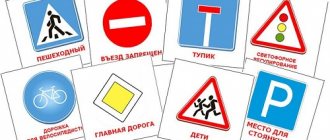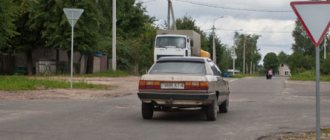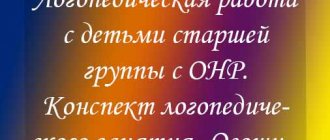Integrated and comprehensive classes
Integrated learning allows you to see and understand any phenomenon holistically; in kindergarten there is a subject-based learning system and it often turns out that knowledge remains scattered, artificially divided according to the subject principle, and as a result, children do not always holistically perceive the whole picture of the world around them.
Integrated classes are a combination of several types of activities. Complex classes within the framework of one topic solve different problems of children's development and are based on different types of activities. These classes can be carried out in all age groups, but they are especially useful with older preschoolers.
The section of the site, integrated and comprehensive classes in kindergarten for different groups, contains many interesting publications for educators on teaching children on various topics:
- Scenario for an integrated lesson in kindergarten
- Integrated lesson on application and ecology in kindergarten
- Summary of an integrated educational activity in kindergarten with children 3-4 years old
- Summary of an integrated educational activity with children 2–3 years old in kindergarten
- Lesson summary for younger children integrated lesson in junior group 2
- Synopsis of the integrated GCD preparatory group of kindergarten
- Summary of GCD in kindergarten
- Summary of an integrated lesson in the middle group of kindergarten
- Summary of an integrated lesson for Victory Day in kindergarten
- Summary of an integrated lesson in kindergarten with children of senior preschool age
- Summary of integrated organized educational activities
- Summary of an integrated lesson on cognitive-speech and artistic-aesthetic development of children in the second junior
- Integrated lesson in the preparatory group
- Summary of an integrated lesson on the Russian language and the surrounding world for a preparatory school group
- Integrated open lesson with children of the preparatory group
- Summary of an integrated lesson for the middle group of kindergarten
- Integrated open lesson
- Integrated lesson for the middle group
- Open integrated lesson on speech development, the environment and mathematics in the preparatory group of kindergarten
- Summary of an integrated lesson on ecology and speech development, senior mixed-age group
- Summary of integrated OOD in the senior group
- Summary of integrated OOD in the preparatory group
- Summary of an integrated lesson in kindergarten
- Summary of the final integrated lesson in the first junior group
The most important thing in integrated classes in a preschool educational institution is the unity of goals, understanding of the techniques, methods, tasks that determine the harmonious development of the child’s personality, in other words, the ability to “crawl”, “enter” the pedagogical process, without creating stress for children, literally physically reducing to level of their eyes and focusing, in organizing their work, on their right-hemisphere characteristics. A fundamentally important point in organizing integrated classes in preschool educational institutions will be the activation of all mental processes that ensure successful learning.
The modern direction of development of the educational system has affected all kindergartens in the country without exception. Now integrated classes in preschool educational institutions are considered popular and most effective. The Ministry of Education approves and encourages the comprehensive development of students, as evidenced by a number of recommendations from the Federal State Educational Standard. What are integrated classes? In general, training according to a similar principle involves the simultaneous development of the child.
Integrated lesson in kindergarten - combines knowledge from various educational fields, on an equal basis, complementing each other (for example: the concept of “autumn” is considered through the means of music, art, painting, ecology). At the same time, in such a lesson, the teacher solves several development problems.
An integrated lesson is an activity that is aimed at revealing the holistic essence of a certain topic through different types of activities, which are combined in the broad information field of the lesson through mutual penetration and enrichment.
Integrated and comprehensive activities in kindergarten. What is the difference? article on the topic
Integrated and comprehensive activities in kindergarten.
What is the difference?
The organization of the educational process in modern innovative conditions requires the teacher to improve practical activities by searching for new value priorities in determining the content, forms and methods of organizing children's cognitive activity.
One of the areas of methodological renewal of preschool education is the design and conduct of integrated and complex classes based on the integration of educational material from several spheres of children’s life activities around one topic or concept.
A preschooler perceives the world around him holistically. For him, objects do not exist separately only within the boundaries of a school subject: animals and plants are from “acquaintance with the environment,” numbers and geometric figures are “mathematics,” etc.
Integrated and comprehensive classes: common features
The goal of integrated and complex classes, built on the interdisciplinary connection of concepts, should be a comprehensive study of an object (subject or phenomenon), meaningful perception of the surrounding world, bringing formed knowledge into the appropriate system, stimulating fantasy, creativity and interest, maintaining a positive emotional mood.
Classes that include interdisciplinary knowledge achieve effectiveness if the following didactic conditions for their organization and conduct are implemented:
- building integrated and comprehensive classes based on concentrating content around one topic
- specification of tasks at each stage of the lesson
- consistent formation of concepts and skills with general content
- rational use of various means of activating children's cognitive activity.
Preschool childhood researcher N. Gavrish in her book “Modern Occupation” provides a detailed analysis of the process of integration, categorical, semantic, structural properties of modern occupation.
She identifies the following types of classes according to the focus of their content:
- unidirectional - subject-specific
- multidirectional - integrated and complex classes [1, p. 22].
Consequently, complex and integrated classes are multidirectional. The main objectives in such classes are: the comprehensive development of the child, the formation of a holistic understanding of a specific subject based on the integration of different concepts with the involvement of children in different types of activities. However, these types of classes have a number of differences.
Integrated knowledge can be included in classes in the form of a fragment (remembering the names of animals that begin with the sound [k]), a separate stage (updating knowledge about true and false natural phenomena when working with fairy tales), during the entire lesson (forming a holistic image of the concept “ Forest", "Insects" and the like).
Integrated lesson
An integrated lesson is an activity that is aimed at revealing the holistic essence of a certain topic through different types of activities that are combined in the broad information field of the lesson through mutual penetration and enrichment [N. Gavrish / 1, p. 22].
The structure of integrated classes requires special clarity, thoughtful and logical interconnection of material from different disciplines at all stages of studying the topic. This is achieved subject to the compact, concentrated use of program material, the use of modern methods of organizing children in the classroom, and interactive work.
At the stage of preparation for conducting an integrated lesson, to maintain systematic knowledge, educators use the method of intellectual maps or maps of mental actions.
An intellectual map is a structural and logical diagram of the content-procedural aspects of studying a certain topic, which reflects in a radial form the connections of the key concept, which is located in the center, with other concepts of this topic (problem) (together they form an inextricable unity) [N. Gavrish / 1, p. 58].
These maps (schemes for studying a concept or topic) help to reveal the essence of the concept being studied in class and its relationship with other objects (phenomena, processes, objects). The developed map is the basis for further modeling and conducting a lesson or series of lessons (if the topic is very large in scope).
For example, for the integrated lesson “Sea” the main concept, which is located in . From this concept there will be words that reveal the essence of the central concept - this environment, sea inhabitants, entertainment, sea transport, properties of sea water (see Diagram 1).
This diagram can also be supplemented with specific examples: names of animals, plants, vehicles, diving equipment, sports, and the like.
Scheme 1. Theme “Sea”.
Such cards for the topic can be compiled from prepared material during the lesson with the children. Of course, in this option it is best to use all kinds of images.
It should be noted that conducting integrated classes requires special preparation from the teacher and an already formed stock of knowledge and skills in children on the relevant topic. Therefore, conducting such classes every day is very difficult.
Examples of topics for integrated activities for children:
- "Water is the source of life"
- "Time in Nature"
- "Far close"
- “Kinfolk” (classes of the animal world)
- “What kind of ball is this?” (study of various round objects)
- “Adults and their young” (animal world).
Several integrated lessons with indicative content:
"Diversity of leaves."
Cognitive activity - analysis of the shape, size and number of representatives of the plant world (Red Book), grouping of plants (flowers, trees, bushes, herbs), physical activity - outdoor game “Day and Night Plants”, speech game - writing a warning story “Caution” ! Plants are predators! (or medicinal plants, etc.), artistic activity - application “November” (selection of geometric shapes in accordance with the shape of the leaves).
"Symmetry in Nature."
Lexical work with the word “same”, experience with mirrors, completing tasks on mosaics (creating snowflakes), searching for symmetry in drawings (depicting representatives of the animal and plant world), making snowflakes, leaves (mirror symmetry) by cutting and imprinting paint on paper, folding patterns from the material “Fold the pattern”, performing symmetry tasks in pairs, subgroups “You are my reflection”.
"Christmas tree".
Guessing and composing riddles about the Christmas tree (determining the characteristic properties - the presence of needles, smell, thorny branches, evergreen), analyzing the shape, size and color, the variety of coniferous trees (“Relatives of the Christmas tree”), creating a New Year tree from geometric shapes, from puzzle material ( “Tangram”, “Pythagoras”), reasoning on the topic “Why are Christmas trees sad after the holidays”? (environmental education).
"Snail".
It is advisable to carry out this activity outdoors, watching a real snail.
Analysis of shape (spiral, circle), size (small), observation of movement speed (slow), didactic game “Who is the slowest?” (comparing the speed of movement of different animals), the outdoor game “Snail” (children draw snails on the asphalt with chalk (a path twisted into a spiral), distribute it into squares and jump in turns), visual activity - coloring with chalk or cutting out a spiral from colored paper.
To conduct integrated classes, you can choose the following as a topic:
1. Single concepts - names of certain animals, plants, natural phenomena, household items, holidays
2. Generalized concepts that include a certain system of objects:
- forest: a collection of animals, plants, recreation;
- sea: a set of animals, plants, transport, entertainment;
- store: goods, sellers, buyers, price, money;
- construction: workers, machinery, equipment;
- class of living nature: animal and plant life, characteristic properties, conditions of existence, protection, benefits and harm;
- bakery: workers, equipment, products;
- park: design, entertainment, plants;
- museum: exhibits, excursion, employees, rules of conduct, etc.
When considering one concept in a lesson, its comprehensive disclosure is carried out, integration is realized. If the main concept is generalized, as a result of an integrated lesson, children develop a holistic picture on a specific topic.
Complex classes
A complex activity is one aimed at comprehensively revealing the essence of a certain topic through different types of activities that consistently change each other [N. Gavrish / 1, p. 22].
Complex and integrated classes are necessarily thematic; in them, a selected topic or key concept is the basis for combining tasks from different types of activities.
Consequently, integrated and complex classes provide for the presence of different types of children’s activities, combining knowledge from different fields. But these types of classes differ significantly from one another, although both are based on interdisciplinary (interdisciplinary) connections.
A complex lesson involves the occasional inclusion of questions and tasks from different disciplines and different types of activities. This promotes in-depth perception and understanding of a specific concept. For example, when studying the topic “Spring. Seasonal changes in nature”, the teacher activates children’s knowledge through conversation, accompanying the conversation with children’s drawings and works of artists.
If the main goal of the lesson is to create a holistic image of “spring,” it will integrate content from different disciplines and include tasks with different types of activities. The peculiarity of such an integrated lesson is that blocks of knowledge from different disciplines are combined in order to create a holistic system of knowledge on a specific topic.
It is also believed that the main goal of integrated classes is to create conditions for children to comprehensively consider a specific object, concept, phenomenon, develop systematic thinking, awaken the imagination, and have a positive emotional attitude toward learning.
“In an integrated activity, unification occurs with the penetration of elements of one activity into another, that is, the limits of such unification are blurred. In such an activity it is almost impossible, or at least very difficult, to separate one type of activity from another. In a complex lesson, one activity replaces another, and this transition is noticeable: we’ve drawn, now we’ll play, and then listen to a fairy tale. A complex lesson resembles a multi-layered cake, in which each of the layers remains separate” [N. Gavrish / 1, p. 23].
The difference between an integrated lesson and a complex one
The content of complex and integrated lessons differs in that in an integrated lesson it is very difficult to divide the task into types of activities. So, for example, in a complex lesson called "Chicken in the Woods' Adventure" (or "Chicken"), the chicken will simply be the main character who will be the key figure in the lesson. Children can be offered the following tasks with different types of activities: educational - a conversation between Chicken and Pinocchio to update knowledge about the rules of behavior in the forest; physical - physical education or outdoor game “Who is faster?”; musical - singing a song about a stream, imitation of the sounds of forest nature, the game “Guess who said it?”, counting activity “What is more in the forest?” and so on.
Accordingly, each of the tasks is related to a general topic, but fulfills its specific purpose in accordance with the type of activity: physical - to develop psychophysical properties (speed, endurance, etc.); artistic - to teach how to convey an artistic image using different means of art, etc. And most importantly, by completing these tasks, children’s knowledge on the topic “Chicken” is not systematized and most likely does not expand.
On the same topic “Chicken” in an integrated lesson you can offer the following tasks:
- a conversation to update knowledge about the character of the lesson or the game “Guess who I am?” (working with cards that depict various properties: color, texture, habitat, size, etc.);
- compiling the story “Why does the chicken squeak?” (you can use a picture)
- performing tasks like “What was - what is - what will be?” (to establish a logical sequence of events - the necessary conditions for the appearance of a chicken (incubator));
- didactic game “Who is friends with whom?” or “Animal settlements” (domestic and wild animals, birds)
- solving simple arithmetic and logical problems (“A chicken eats half a glass of millet a day. How many glasses does a chicken need for 2 days?” etc.)
- designing from geometric figures (taking into account shape, size, composing elements from individual parts) - this task can combine artistic, cognitive and speech activities of children
- proof of the statement “chicken can’t swim” (examination of structural features).
In the mentioned tasks, it is difficult to determine which goal is the main one, since they are integrated in nature, allow you to consider the main concept (topic) from different angles, and reveal the main properties and features of the object.
By completing all these tasks, children systematize their knowledge on the topic “Chicken” and have the opportunity to learn something new.
Taking into account the age characteristics of children when conducting integrated and complex classes
There are no age restrictions for conducting comprehensive and integrated classes with children. The main thing is the teacher’s ability to organize the work of children in class, the correct choice of the topic of the lesson and its content.
The above-described approximate content of the integrated and complex lesson “Chicken”, with an appropriate level of preparation and selection of tasks appropriate to the children’s age, can be carried out by the teacher in the younger group.
Moreover, we note that almost all classes with young children are complex.
General recommendations:
When planning to conduct integrated and complex classes in your work, you should remember that such classes require special training for both children and the teacher. Accordingly, conducting such classes every day is a colossal burden, primarily on the teacher.
When preparing integrated and complex classes, you need to know the basic requirements for planning and organizing their implementation:
- highlight in the program from each discipline (area of life) similar topics or topics that have common aspects;
- identify connections between similar knowledge elements;
- change the sequence of studying the topic, if necessary;
- take into account specific tasks in the process of studying the topic for each discipline;
- when planning a lesson, formulate the main goal and task;
- model the lesson (analysis, selection, verification) of the content of the lesson, fill it with material that meets the purpose of the lesson;
- identify the optimal load for children (mental, physical, speech activity, etc.).
Conducting integrated and complex classes provides ample opportunities to use a variety of visual aids in the classroom. This way, the teacher can use children's drawings to create examples and model problems. Using these same drawings, you can compose short stories and fairy tales with your children.
Conducting an open integrated and comprehensive lesson in a preschool educational institution
Any open lesson is conducted according to general rules that are important to follow. Preparing an open lesson is painstaking work and a huge psycho-emotional load. After all, a person not only finds himself under meticulous and close attention, but also becomes the personification of the institution in which he works. Parents often correlate the institution with the personality of the teacher (which, of course, is wrong, but this is not felt at the time of the lesson). Each parent goes to an open lesson with their own expectations, and the teacher tries not to disappoint them. This is where the teacher must stop. The lesson is held for children, and parents are spectators. You shouldn’t try to please everyone and show everything at once.
A diagram of the basic rules for preparing an open lesson allows you not to lose sight of anything important
The teacher must understand that there are no trifles in this case. The simple absence of an extension cord will make it impossible to use some didactic or other material. It is also important to understand the fact that technical failures may occur. Therefore, it is necessary not only to check the equipment in advance, but also to think through the moments of possible failures in advance. If a child is sick and he has most of the required poem, then the lesson is also in danger of being disrupted.
When preparing an open lesson, think through possible unplanned moments. This will allow the teacher to get out of any situation with dignity.
Currently, Internet technologies are developing and opportunities are emerging for online broadcasting of open classes. In this case, the main thing is to position the camera correctly and conduct the lesson so that the children are in the frame the entire time.
When broadcasting online or demonstrating in a recording of an open lesson, there are a number of obvious advantages:
- Eliminates the preparation of materials for parents and their notification and instruction, which allows you to devote more time to working on the lesson itself.
- Allows educators to avoid difficult situations with parents. Especially in those moments when parents try to help their child cope with a task, mistakenly assuming that he cannot do it.
- Children are not distracted by the presence of strangers.
- Subsequently, the video recording allows you to competently and comprehensively analyze the lesson.
- The lesson takes place in a familiar environment for children.
- The parent has the opportunity not only to observe his child at the moment, but also to save the recording in the archive for a long memory.
Final open lesson
A distinctive feature of the final classes is that they should clearly demonstrate to both children and adults what they managed to learn during the reporting period. In kindergarten, such classes are most often held at the end of each semester. It would be a big mistake to try to create a lesson out of everything that you managed to teach your students. It is best to take as a basis a topic (in this case it will be more convenient to use a complex form) or a section (an integrated lesson is suitable here) and collect those forms that are most effective for the entire group. We must not forget that personal achievements and group achievements are different concepts. In an open lesson, the teacher shows the work of the group as a whole, and not of individual children.
Logical and correctly selected material is the basis of a good open final lesson
Another mistake would be starting incorrectly. If you have chosen a topic, then you should not try to make an integrated lesson out of it, it is better to make a high-quality comprehensive one. If the concept and its consideration from the points of view of different topics were taken as a basis, then special attention should be paid to a logical and consistent presentation.
Structure and timing of the lesson
When preparing any lesson, SanPiN rules apply, which clearly regulate the duration of the event. Considering that open, integrated and complex classes are recommended for children aged 3–4 years and older, the duration of such a lesson can vary from 15 minutes in the second youngest group to 30 minutes in the preparatory group.
You can learn more about integrated and comprehensive classes in the senior group from our article - Integrated and comprehensive classes in the senior group of preschool educational institutions.
The rules and regulations of SanPiN take into account all the psychophysiological characteristics of children of different ages, so it is undesirable to violate them
The structure of any lesson in a preschool educational institution consists of 3 successive stages:
- Introductory part - 2–5 minutes. The teacher shows the children something bright, interesting, and exciting.
- The main part is 12–25 minutes. Includes several activities and a music or physical education break.
- The final part is 2–5 minutes. Summing up and reflection.
In order to conduct an integrated lesson, several different classes can be combined (for example, educational, musical, physical education, etc.). In this case, one type of activity should not exceed the interval recommended by regulatory documents and there must be an alternation of dynamic and static moments.
Integrated lesson in an early age group. Abstract
Summary of an integrated lesson in kindergarten for children 2-3 years old “Journey through a magical forest.”
Children's age: 2-3 years. Audience: kindergarten teachers. Educational areas: social and communicative development, Speech development, Cognitive development, Physical development, Artistic and aesthetic development. Preliminary work: looking at illustrations and reading fiction about wild animals, conversations on the topic “wild animals”, “who lives where?”, learning finger games, dancing with carrots, playing with mushrooms and pine cones, modeling salt dough. Tasks by area: - To consolidate children's understanding of wild animals (name, who eats what and what? Where does they live?) - To consolidate the signs of spring. — Develop memory, thinking, perception. — Promote the development of children's vocabulary through play activities, fine motor skills and tactile sensations. - Give children joy and pleasure from joint activities. — Cultivate friendly relationships, a desire to help. — Cultivate interest in musical and creative activities. — Strengthen the ability to distinguish and name primary colors: red, yellow, green, blue. — Consolidate knowledge of sculpting techniques: rolling a ball between your palms in a circular motion. — Develop the skill of using salt dough carefully. — Create a friendly, emotionally rich atmosphere. Design: Magic forest. Material for the lesson. Toys: hare, squirrel, bear, sun, clearing with flowers, 2 baskets with mushrooms and nuts, salt dough Plot and course of the lesson. Organizational moment Educator: Guys, look, guests came to us today, let's say hello to the guests, smile at them and at each other. Educator: Guys, look who else came to visit us? Children: sunshine. Educator: - The sun came to visit us and invites us on a journey. And we will go on a trip on a train. Chug chug. (Music plays.) Well, here we are.
Educator: Guys, look at the path in front of us. Let's walk through it. And around, look, there is a forest. The sun is looking from the sky. Yes, how pure, kind, radiant. Educator: Guys, let's look at the sun, what is the sun missing? Children: Luchikov. Right. Educator: Let's decorate the sun with rays?
Educator: Look, children, how bright and beautiful the sun has become. Well done guys completed the task. Let's continue traveling through the forest. Educator: Look what’s on our trees? Children: leaves. Educator: What color are the leaves on the tree? Children: Green. Well done. Educator: when do our leaves bloom? Children: In the spring. Educator: Look, what kind of tree is this? Children: (Christmas tree) Educator: Guys, guess the riddle: She lives on the Christmas tree and gnaws nuts. Children: (Squirrel). Who is sitting on the branch? (squirrel) - Look, does the squirrel have eyes? Do you have eyes? Does a squirrel have a nose? Where is your nose? Does a squirrel have ears? Where are your ears? etc. children show body parts. I was jumping on the branches, collecting cones for the children, but the basket suddenly fell, I lost everything here. Help me guys. We need to help the squirrel sort nuts into one basket and pine cones into another basket. Educator: Oh, what great fellows, they coped with the task. Let's go further into the forest. Goodbye squirrel.
Educator: Look, guys, there’s a clearing in front of us, let’s sit down in the clearing. Look what flowers? The wind blew and all the butterflies flew away from the flowers, let's help the butterflies return to their flowers, you need to plant a butterfly on each flower in color. Well done. Let's go further into the forest. Educator: Guys, guess the riddle: He jumps deftly, loves carrots. (bunny). Educator: Oh, who’s sitting here? Children: A hare is sitting under a stump. Educator: do you know a poem about a bunny? A poem by A. Barto is recited: “The Mistress Abandoned the Bunny.” Well done boys . Why is our bunny sad? Let's have fun with the bunny and dance the "carrot dance." We give carrots to the bunny. Thanks guys for the carrots. Goodbye bunny! Educator: Let's go further into the forest. Educator: Let's guess the riddle: He lives in a forest thicket, He loves raspberries and honey. (Bear).
Educator: Oh, look who’s waiting for us here. Children: Bear. Let's act like bears. The children repeat after him. Educator: “The clumsy bear is walking through the forest.” The children repeat after him. Educator: Guys, let's bake gingerbread for the bear. The bear will be very happy! Children: yes. Educator: To bake gingerbread cookies, you need to take the dough (demonstration). I take the dough in my hands, I remember the dough now. Like this, like this, I mold a round ball. Like this, like this (roll out the ball in a circular motion) And now I’ll press the ball, press very, very hard, it’s a round gingerbread, I’ll treat the bear with something sweet. Children make gingerbread cookies. The teacher helps children if necessary. Educator: Place the gingerbread cookies in plates. Well done boys! We baked beautiful gingerbread cookies, the bear will love them.
Bear: And here are the guys and you have a treat from me. Eat for your health. Goodbye bear. We walked in the forest, saw all the beauty, and now it’s time to say goodbye and return to our group. Educator: Do you hear, guys? (the train signal sounds) Who drove up behind us? (Children's response) Children imitate the movements of the train and leave. Reflection summing up.
We recommend watching:
Integrated lesson with children of the first group of early age Synopsis of educational activities in the 1st junior group on familiarization with the outside world. Visiting a fairy tale Technological map for organizing joint activities with children of the 2nd early group Synopsis of educational activities in the early age group with presentation
Similar articles:
Lesson notes for the 1st junior group of kindergarten. Introduction to clay
Lesson summary for an early age group. Getting to know the sun
Summary of a game development lesson in kindergarten in the second group of early age on the topic: Animals
Summary of a game lesson for children of the third year of life on the topic: Octopus
Summary of a game lesson for children of the third year of life on the topic: Clocks
